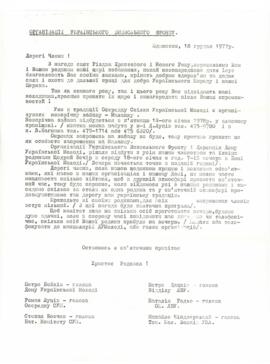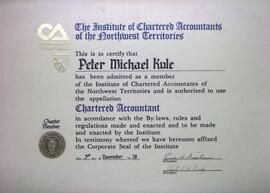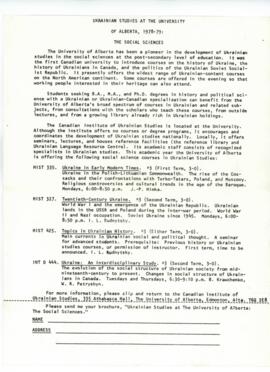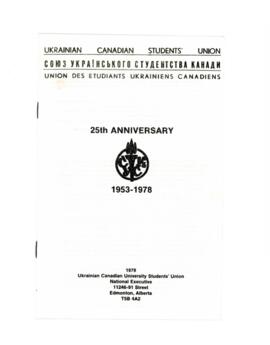This item is a recording of a CEESSA Meeting where the roles and nomination process for the committee was discussed.
This item contains recordings from the Second Banff Conference on Central and East European Studies.
Presentation by Mr. Petr Czarnowsky: Eastern Europeans, despite their proportion of the population, came to form a large number, often over 50% of ethnic associations in Alberta. This includes ethnic organizations, arts organizations, and linguistic schools. Policies of multiculturalism have helped to form these figures, but have had the unforeseen consequence of adding to confusion about Eastern European ethnic groups on the part of students and teachers alike.
Presentation by Mr. Joanna Mateko on the problems already being faced in the study of Poles. She came from Poland associated with the Polish Academy of Sciences in Warsaw for 15 years. She did work in the field of Polish history, having published numerous articles and co-author of bibliographies that were compiled by the Polish academy of sciences. She does her research on the Poles in Alberta. A problem that exists in the study of Poles is the inaccuracy of academic and official documents pertaining to Polish settlement in Canada, and the difficulty in unearthing accurate depictions and statistics of Polish settlers, and Slavic settlers more generally. This can be derived from a lack of knowledge from Canadian officials, and a lack of consciousness amongst many Slavic groups, particularly the Poles and Ukrainians.
Presentation by Mr. John Sokolowski, a graduate student in the department of Slavic Languages, his first graduate program was as a Classicist. He does work on the Russians and Belarussians. He started his work on the East Slavs, the Russians, Belarussians, and Ukrainians in Alberta. They no longer work on the Ukrainians as so much work has been published. They started their study with the Russians and Belarussians, they hope to determine an accurate number of people of Russian and Belarussian origin in Alberta. Contention on the accurate number of Russians and Belarussians in Canada, as the definition of Russian has changed over time, with many early documents associating many non-Russian ethnic groups as Russian. Dynamics have changed with census records over the years, which still continue to be unreliable. There is thought to be far more Belarussians in Canada than official census documents would suggest.
Presentation by Mrs. Dr. Yermilla Horna University of Calgary Department of Sociology. Dr. Horna was educated in Prague and Bratislava came to Canada in ’58, taking part in the project doing the history of the Czechs and the Slovaks. She got a grant for the study of patterns of adjustment of Czechoslovaks, the so called refugees of 1968-1969. The study focused on pre-1968 settlement of Czechoslovaks in Canada to figure out if incoming refugees had a previous basis to go off of, or had to ‘start from scratch’. Research found majority of Czechoslovaks came to Alberta as miners, farmers, or other labourers, mostly from Slovakia. Greatest wave of Czechoslovak migration prior to 1968 came in 1885.
Presentation by Mr. Kostash: Talks about the function of universities. Talks about how East European and Soviet Studies at the university follows the same functions. Mentions that one who takes particular focus on the East European courses offered by the University can find themselves being skilled and knowledgeable scholars. Initiatives by professors at the university to make sure students in the field go out to the ethnic communities to get a feel for how they are. Talks about the importance of community approval and funding for new programs. Stresses transparency of activities in programs as it relates to the community.
Presentation by Mr. Duruviches, a member of the Lithuanian community, and President of the Baltic Society: Discusses the contention with the label ‘Soviet’, coming from Lithuania, and the history Lithuania has with the Soviet Union. The importance of having a place such as a University to study one’s heritage. Expects from the University that it is kept in mind that although their issues are similar at the moment, that Baltic peoples are not Slavic peoples.
Presentation by Dr. Bergin from the Faculty of Education: has a strong interest in Mennonite culture. Difficulties because of mixed loyalties on representing different groups; particularly the Mennonites, who aren’t easily identified by typical visages.
Presentation by Dr. Sukoversky: the definition of a collection, and that professors start collections. Students can start collections too. Ethnic groups can start collections.
Presentation by the Chairman of Edmonton Historical Board
Presentation by Mr. Kistner: Wasn’t prepared to present but is talking from the perspective of a foot soldier. He is Baltic German born in Tallinn Estonia. Talks about how maps often forget about the islands of Estonia. Baltic Germans is a very small group. It’s worthwhile for even very small groups to write their history and preserve their heritage. In doing work there’s lots of assistance needed, time, and footwork. Being a small group has its advantages, no need for sampling.
A collection of Ukrainian provers collected in Alberta for the UKR-421 course and their explanations. The sources include following interviewees: Dmytro Petriw (Roman's father), Bohdan Medwidsky, prof. Zujewsky, pani Prits', pani Ianyshevs'ka, prof. Carlton, Zenon Paranych (Roman's grandfather), maestro Kolesnyk, pani Husak, pan Vasyliv.
A collection of texts including spring songs (haivky), kolomyiky, religious songs, love songs, wedding songs, Easter songs, harvest songs, as well as descriptions of wedding customs and rituals collected from Alberta residents.
Petriw, MyraIncludes wedding songs and customs, harvest songs, spring songs (hahilky), love songs, humorous songs, Cossack songs, carols, Malanka songs, kolomyiky, and proverbs collected by Irene Scharabun for the UKR-421 course at the University of Alberta.
This certificate was awarded to Peter Michael Kule by the Institute of Chartered Accountants of the Northwest Territories, recognizing him as a Chartered Accountant. This certificate has been signed by both the president and secretary of the Institute of Chartered Accountants of the Northwest Territories.
The material was collected by Roman Brytan for his UKR-421 course at the University of Alberta. The collection consists of texts and some musical scores for songs sung in Alberta communities. Contains musical scores for some songs and choreography for dance songs.
The audio recording contains songs recorded in Edmonton from Sophia Klymkovych, Mykhailo Shmihel's'kyi and Maria Bukyda in December 1978.
Artistic director Anatolii Avdiievskyi.
The poster was created by Ukrainian Artist Liubov (Lyubov) Panchenko for the Veriovka Choir concert in 1978.
The collection consists of field materials collected by Roman Brytan while taking Ukrainian Folklore courses at the University of Alberta. It covers the following topics: Ukrainian folk songs both from Ukraine and Canada, ritual songs, and superstitious recollections.
Brytan, RomanThe collection consists of Ukrainian proverbs, jokes and comic tales collected in Alberta for Ukrainian Folklore courses taken by Roman at the University of Alberta.
Petriw, RomanA collection of songs and customs collected from Alberta residents: Mariia Mykytiv, Hafiia Ianyshevs'ka, Iustyna Visniuk, Maria Husak, Marusia Kuz'o-Hura, Ol'ha Hladun, includes carols (koliadky i shchedrivky), spring songs (haivky), kolomyiky, religious songs, love songs, wedding songs, Easter songs, harvest songs, as well as descriptions of wedding customs and rituals.
The audio cassettes contain carols, shchedrivky, religious songs; wedding songs; folk songs; ballads; kolomyiky; obzhynkovi songs; Easter songs recorded by Myra Petriw from Ol'ha Hladun, Maria Kuzio-Hura, Iustyna Visniuk and Maria Husak.
Petriw, MyraCollection of texts of songs and verses collected by Christine Nebozuk for her UKR-421 Ukrainian Folklore class at the University of Alberta from informants from Western Ukraine. Contains text to songs given by informants.
Nebozuk, ChristineThe collection consists of fieldwork materials collected by Nadia Dmitriuk for her Ukrainian Folklore courses at the University of Alberta and include proverbs and sayings, as well as wedding songs and other traditional songs.
Dmitriuk, NadiaThe collection consists of an essay that analyzes comic elements of Walter Rutka's album "The Ukrainian Cowboy", and an audio cassette, which is a field recording of Walter Rutka singing the following songs: 1) Mansion on the Hill, 2) Bashful Dancer, 3) Homebrew, 4) Lara's Theme, 5) Pryvit, 6) Kolomyika, 7) Molodyi Viter.
Korban, JoanneThis document commemorates the recipient for contributions to the Stadium Seat Endowment Plan. The endowed names appear on a plaque on the south concourse wall of the Commonwealth Stadium. The stadium was completed for the Commonwealth Games held in Edmonton, Alberta from August 3rd to 12th, 1978. The scroll is signed by the president of The XI Commonwealth Games Canada (1978) Foundation, Maurice Lewis Van Vliet.







